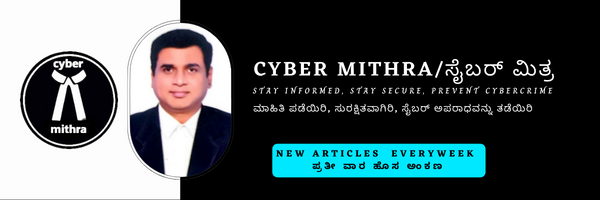All you need to know about WhatsApp Cybercrimes
There are over 600 million WhatsApp users in India, which means about one-third of the country’s population uses it. Now cyber fraudsters are constantly finding new ways to deceive people through WhatsApp. I had in my earlier column had talked about WhatsApp international call fraud. In this column, I am going to tell you about some of the major cyber crimes that are carried out using WhatsApp.
Major cyber crimes carried out using WhatsApp include :-
Crimes committed in the guise of seeking help : Here you get a message from your friend’s or relative’s fake or hacked WhatsApp account demanding money from you on the pretext that they have met with an accident or to pay the hospital bill or something else. If you trust and give money, it goes to the cybercriminals’ account and they will harass you for more money with various excuses until you stop giving any more money.
Gift card scams : One day, you will receive a WhatsApp message saying, “You have won cash prize or any other attractive item in a Lucky Dip. Click on the link given below and provide your details to get it.” As soon as you click on that link out of curiosity, your smartphone or computer will be hacked by the hidden malware in that link and using it cybercriminals will steal your sensitive information and commit various cyber crimes on you.
Verification code/ WhatsApp hack scam : This starts with you receiving two consecutive messages. A stranger calls you and tells you some believable story that due to a mistake I entered your number instead of mine and you have received a code on your phone number, please give it to me. If you trust and share that code, your WhatsApp account will be hacked using it. Once hacking your WhatsApp account, they will then con your friends and relatives by approaching them as you and they may even hack their WhatsApp accounts also.
Image Download Fraud : You receive a WhatsApp message with an image that intrigues you, and if you click on it out of curiosity, the malware embedded in the image, through steganography, takes control of your smartphone or computer and steals the information contained therein or steals the OTP and helps cybercriminals hack your WhatsApp or other social media accounts.
To protect yourself from such WhatsApp fraud :-
- Always follow the principle of ‘Patience, Zero Trust and Verification’ for all digital transactions.
- Do not click on hyperlinks in any messages from unknown numbers and do not scan QR codes.
- Never share your personal or financial sensitive information, including your phone number, on any public websites or social media platforms.
- Be wary of anyone who contacts you and offers help through replies or comments to your messages, verify their authenticity before you talk to them or share details and information with them only after confirming the same.
- Before giving OTPs or code to strangers, read what the OTP/code is for, confirm it and then share it.
- Implement two-factor authentication for your WhatsApp account immediately.
If you are a victim of WhatsApp fraud :-
Immediately call 1930 Cyber Helpline or file a complaint at cybercrime.gov.in or the nearest police station. Report the fraud on the bank/brokerage website, file a complaint and freeze the debit on the transferred amount also inform WhatsApp or Meta customer support if your account is hacked. If you think your device is infected with malware, take a backup of it and format it or do a factory reset.
Legal remedies available to victims:-
You can file a criminal case at your nearest cyber or general police station under the following legal sections or as suggested by the police based on your case:
- Indian Penal Code (IPC) Sections 303 (Theft), 319 (Punishment for cheating by impersonation), 336 and 318 (Cheating), Section 323 (Unlawful extraction of data), Section 329 (Criminal trespass), Section 338 (Forgery), Section 337 (Punishment for forgery/forgery), and Section 340 (Use of forgery/forged document).
- Information Technology Act (IT) Act 2000/08 Section 43 (Penalty and compensation for damage to computer, computing device etc.), Section 65 (Wrecking computer), Section 66 (Punishment for computer related offences – person who steals data, spreads virus to system, destroys data, hacks, or denies access to computer or network to authorised person), Section 66C (which provides for penalty for identity theft and fraudulent or dishonest use of a person’s identity information) and Section 66D (Punishment for fraud committed by impersonation using computer resources).

